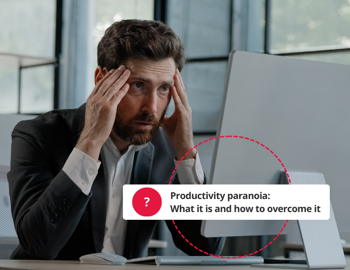
What is productivity paranoia?
Productivity paranoia is the belief that employees aren’t being productive, even when evidence suggests otherwise. It typically arises in remote and hybrid working environments, where managers can’t physically see their teams working. As a result, they may assume that productivity is dropping, despite employees often working just as efficiently – or even more so – than in traditional office settings.
This paranoia stems from a misalignment between perception and reality. While employees may feel they’re working harder than ever, managers who aren’t able to see this first hand might not be convinced. The issue isn’t necessarily about productivity itself but rather how it is measured and evaluated in the workplace.
What are the underlying issues that cause
Several factors contribute to productivity paranoia, many of which are linked to workplace culture, management style and traditional perceptions of work. Let’s explore these causes in more detail.
Lack of trust
At its core, productivity paranoia is a trust issue. When leaders trust their employees, they focus on results and empower them to work autonomously. However, in workplaces where trust is lacking, managers may feel the need to constantly monitor activity, leading to a breakdown in relationships and overall performance. A company culture that fosters trust and accountability is key to overcoming these concerns, and can yield more benefits than just reducing productivity paranoia.
Reduced employee visibility
The shift to remote and hybrid working models means that managers can no longer rely on physical presence as a measure of productivity. Without casual office interactions, impromptu meetings or the ability to actually see employees working, some leaders struggle to gauge output effectively. This can create anxiety over what employees are getting up to during their scheduled hours.
Too much emphasis on working hours
Measuring productivity based on hours worked rather than output can be misleading. Some employees are more productive in shorter bursts, while others may work unconventional hours to balance personal and professional commitments. A rigid focus on time rather than results can lead to disengaged employees and a culture of presenteeism rather than meaningful work.
Different management styles
Not all managers lead in the same way. Some take a hands-off approach, trusting employees to manage their own workload, while others prefer close oversight. While either of these can be effective when balanced with employee needs and business goals, those who micromanage are more likely to experience productivity paranoia, as they struggle to relinquish control and allow their teams to perform independently.
One-size-fits-all thinking
Different employees work in different ways. Some thrive on structured schedules, while others are more productive when given flexibility in their hours or the freedom to choose alternative approaches. Expecting everyone to follow the same working style can lead to inefficiencies and a lack of engagement. For employers to manage productivity more effectively, it can help to explore motivation theory and identify individual drivers of performance.
What are the consequences of productivity paranoia?
When productivity paranoia takes hold, it can have serious consequences for businesses, affecting everything from employee morale to long-term competitiveness. Let’s take a look at some of the most significant negative effects of this unhealthy mindset.
Erosion of trust
If managers constantly question productivity levels, employees will begin to feel untrusted and undervalued. This creates a cycle where workers then stop trusting leaders, resulting in disengagement, decreased performance and increased frustration.
Poor teamwork
Productivity paranoia breeds resentment and suspicion, making it harder for teams to function effectively. When managers or colleagues assume that others aren’t pulling their weight, it can result in miscommunication and poor teamwork, in turn damaging workplace efficiency and innovation.
Employee burnout
When employees feel that they need to constantly prove that they’re working hard, they may take on excessive workloads, skip breaks or continue working outside of their contracted hours. Over time, this leads to exhaustion and an increase in absenteeism rates, as workers struggle to maintain a sustainable work-life balance.
Higher turnover rates
A workplace culture driven by suspicion and pressure isn’t one that retains talent. If employees feel that they’re constantly being scrutinised or undervalued, they’ll look elsewhere for a more supportive environment. Excessive staff turnover disrupts operations while also increasing recruitment and training costs, causing talent and budget inefficiencies for your organisation.
Loss of competitiveness
Some businesses may end up overcompensating for productivity paranoia, meaning they risk losing out on top talent and falling behind competitors. Removing hybrid working options to increase visibility or creating an oppressively restrictive environment makes a company less appealing to prospective employees. HR benchmarking can help you to assess employee sentiments and evaluate how your organisation compares to other businesses in the market.
Legal and ethical concerns
Employees have the right to disconnect, and they shouldn’t feel pressured to work beyond their contracted hours. Excessive monitoring or unrealistic expectations about workloads can lead to legal challenges, as well as ethical concerns around workplace wellbeing and respect for personal time. It’s therefore important to set and stick to strict boundaries around employee hours and how you manage productivity.
How to overcome productivity paranoia
To combat concerns around employee productivity, businesses need to adopt strategies that promote transparency, trust and a results-driven mindset. Here are some top tips to help your organisation to steer clear of productivity paranoia.
Implement project management tools
Using project management tools provides visibility without the need for micromanagement. Employees can log progress, set deadlines and update task statuses, giving managers real-time insights into workloads and timelines without unnecessary oversight.
Embrace regular communication
Encouraging open and improving workplace communication helps managers and employees to stay aligned, and makes it easier to discuss any concerns around productivity productively. Regular check-ins, team meetings and status updates provide reassurance and clarity without being intrusive.
Respect employee availability
Managers should avoid contacting employees while on leave or expecting responses outside of normal working hours. Respecting flexibility and personal time helps to build trust and ensures that employees maintain a healthy work-life balance.
Focus on outcomes, not hours worked
A shift towards tracking performance based on results rather than time spent working is essential for avoiding productivity paranoia. The growing interest in the four-day work week highlights how businesses can achieve the same, or even better, results by prioritising efficiency over rigid schedules.
Hold regular employee appraisals
Regular staff appraisals allow managers and employees to align expectations, address concerns and set clear performance goals. This ensures that everyone understands what’s required and empowers them to work towards shared objectives.
Recognise and reward performance
Acknowledging achievements and providing incentives naturally encourages employees to focus on their performance. Whether through bonuses, promotions or just saying thank you for a job well done, businesses that reward employees for their contributions create a culture of motivation and engagement.
Manage your employees more effectively with PeopleHR
Productivity paranoia can damage workplace culture, reduce trust, and lead to disengagement, burnout, and high turnover rates. By focusing on transparency, communication and results-driven performance, managers can create an environment of trust where employees thrive. In turn, this helps businesses to drive profitability and foster innovation while providing a competitive edge that supports long-term growth.
Our HR software helps businesses to better manage employee performance, streamline communication and improve transparency, making it easier to track progress without resorting to micromanagement. To see how PeopleHR can support your team, request a demo or get in touch with us today.
